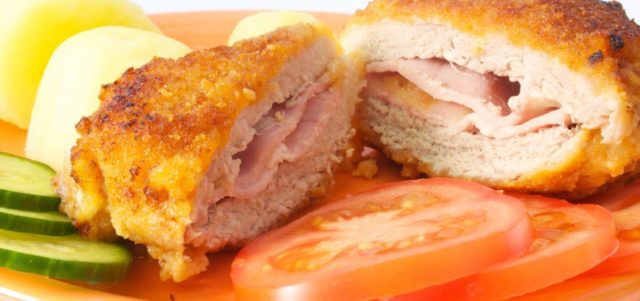
Annually observed on April 4 is National Chicken Cordon Bleu Day. It is all about a special dish combining chicken, ham and cheese.
This delicious dish is most basically described as a piece of cheese wrapped in a piece of ham stuffed in a butterflied chicken breast, breaded, and fried. It’s a wonderful combination of flavors and preparation techniques, which has created an iconic dish that always calls back to the restaurants and cafes of Paris.
One of the little known facts about Cordon Bleu is that it merely means that the French believed this dish to be of prize winning quality. “Blue Ribbon” being the direct translation, and the implication being much the same as it is in any county fair.
One variation not commonly known outside of its home of Switzerland, is the Schnitzel Cordon Bleu. The primary difference here is that the meat is thinned out, breaded, and two Schnitzel are put together with ham and cheese between them, the variant here also lies in the selected cheese. Ironically, rather than the Swiss cheese so popular in the French and American versions, this variant instead uses Emmentaler or Gruyere for its dairy portion.
A similar variant comes from Hungary, where veal is used in place of the chicken, but the filling is the same. It’s popularly served with mashed potatoes, French fries, or rice, though it’s not unheard of for any other vegetable to accompany the meal, along with breads.
- According to Larousse Gastronomique cordon bleu “was originally a wide blue ribbon worn by members of the highest order of knighthood, L’Ordre des chevaliers du Saint-Esprit, instituted by Henri III of France in 1578. By extension, the term has since been applied to food prepared to a very high standard and to outstanding cooks. The analogy no doubt arose from the similarity between the sash worn by the knights and the ribbons (generally blue) of a cook’s apron
- Chicken Cordon Bleu is a relatively recent American creation, first found mentioned in the written word in 1967.
- Common variations on this recipe include baking instead of frying, skipping the breading, and switching the order of the meats.
- The dish did not originate at any of the prestigious Cordon Bleu cooking schools of Europe as often thought.
- There are many regional dishes from Europe that share characteristics with Chicken Cordon Bleu. Some of the countries that include roulades, or roll ups of meat, in their cuisine are Germany, France and Italy.
- In largely Muslim-populated countries, the halal versions of chicken cordon bleu are also popular, but to cater to the halal requirement for the Muslims, the chicken is rolled around beef instead of a pork product
Sources:












